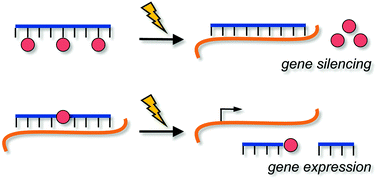Translational control of gene function through optically regulated nucleic acids
Abstract
Translation of mRNA into protein is one of the most fundamental processes within biological systems. Gene expression is tightly regulated both in space and time, often involving complex signaling or gene regulatory networks, as most prominently observed in embryo development. Thus, studies of gene function require tools with a matching level of external control. Light is an excellent conditional trigger as it is minimally invasive, can be easily tuned in wavelength and amplitude, and can be applied with excellent spatial and temporal resolution. To this end, modification of established oligonucleotide-based technologies with optical control elements, in the form of photocaging groups and photoswitches, has rendered these tools capable of navigating the dynamic regulatory pathways of mRNA translation in cellular and in vivo models. In this review, we discuss the different optochemical approaches used to generate photoresponsive nucleic acids that activate and deactivate gene expression and function at the translational level.

- This article is part of the themed collection: Nucleic Acids


 Please wait while we load your content...
Please wait while we load your content...